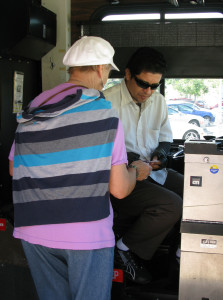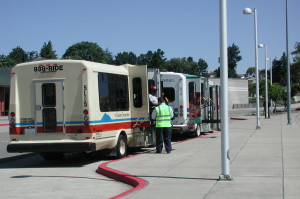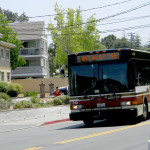Buses today are very different from the buses that were on the road 30 years ago. They have been through many technological advances and improvements. As far back as the late 1980s, buses began to change in ways that particularly increased accessibility for many riders. Recently, buses have seen changes that take advantage of the internet and wireless communication. Now, we are on the cusp of seeing great advances in zero emission buses, as well as driver assisted buses. Finally, we might (sooner rather than later) see the emergence of an autonomous bus! However far off that may be, today’s buses have come a long way since 1986.
A vast majority of buses once had stairs that had to be navigated in order to board. In 1990, buses with boarding stairs were called high floor buses. Today, almost all buses are low floors buses and boarding stairs are gone. This makes getting on and off a bus much easier and allows for people with disabilities and for many seniors to use bus transit. In a related technological development, wheelchair tie downs first appeared on buses beginning in the late 1980s. That is now standard equipment on all buses.
As we entered the new century, technological advances on buses really took off. It is now common:
- To find buses that are fully Wi-Fi compatible.
- For bus stop announcements to be automated.
- To see exactly where buses are located in real time.
- For customers to use their laptop or smart phone to see exactly when their bus is going to arrive at the bus stop they want to use.
In addition, electronic ticketing has made using multiple transit systems across the Bay Area much easier; and a single fare instrument can be used to make multiple system trips.
At County Connection, our entire fleet of buses are now fully Wi-Fi equipped, and they will accept the Clipper card. This follows up on the completion of our Bus Tracker project in 2013. Bus Tracker allows a passenger to use their laptop, smartphone, etc. to determine when their bus is coming to their stop. This means that a rider can use Bus Tracker to determine when to board a bus, which is low floor with the latest and greatest in vehicle safety features, that will get them to a BART station in time to catch a train, all the while using their Clipper card on both systems. Moreover, they can work or surf the net on their device of choice, as they ride their bus and BART; perhaps into San Francisco.
As to what is coming next, County Connection has begun to move its technology with buses towards the realm of zero emissions in the form of electric buses. This fall, we will deploy the first of our electric buses in Walnut Creek on our downtown trolley. More projects of this type are in the works and will be available in the future.
Perhaps just as exciting is the likelihood of driver assisted buses coming along within the next five years. These buses will assist the driver in pulling in and out of bus stops; alert the driver to blind spot hazards; assist the driver in negotiating tight lanes; and more. Finally, the transit industry is watching the rapid development of autonomous vehicles very closely. As this progresses, the development of an autonomous bus or bus that can be put on “auto pilot” may not be all that far off.
With all these advances, it is clear that today’s bus is not anything like yesterday’s bus. And, tomorrow’s bus promises to be even more evolved than today’s advanced bus. While it is rewarding to be a part of public transit and watch the transformations this industry is striving towards, and it is also very good for the public we serve.







